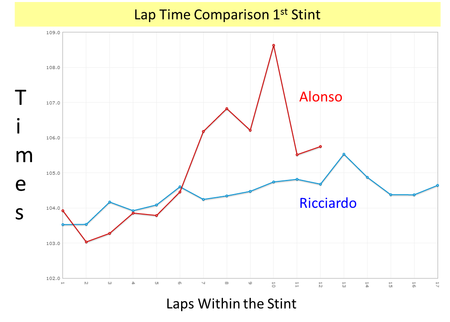Race Engineer: “Primes - but he (Daniel Ricciardo) stopped later than you”
Sebastian Vettle: “Tough luck!”
The Chinese GP didn’t give fans anything to shout about but it did provide the type of set up economists love by throwing up a mix of strategies, gains and losses based on the constantly evolving track and tyre conditions. The circuit comprises two 270° right hand corners which caused all to suffer from left front graining and it proved to be a limiting factor during the race.
Generally the trend this season compared to last is to pit one less time in race conditions. Last year, the soft and more grip-giving tyre (which is 0.6 - 0.8 of a second faster over 1 lap when used as a new set) gave optimum performance over 5 – 6 laps during a three stop strategy. This year the majority of leading runners have been aiming for two stops in race conditions as they can eek more life out of the softer rubber without falling off a performance cliff as quickly. Eight laps into a stint in Shanghai the medium tyre became quicker as graining caused the soft compound to lose performance which essentially means that 0.6 - 0.8 of a second advantage gets whittled down and then becomes slower after those eight laps.
Pre-race models demonstrated that a two stop strategy would be about six seconds quicker than a three stop strategy but care would be needed to enable than to happen. The graph below shows that Fernando Alonso went for a three stop strategy. He took the life out of soft tyres and dumped them after 12 laps. Ricciardo went for a two stop strategy. He managed to squeeze 17 laps out of his tyres and produce competitive lap times. So why did Alonso rather than Ricciardo finish on the podium? Because Ricciardo he could not get past his team-mate Sebastian Vettel (despite implied team orders).
Vettel was initially on a three stop plan but by lap 25 everyone had decided a two stopper was the optimum strategy. If Vettel had let Ricciardo through on lap 23 then Ricciardo would have caught Alonso with four laps to go. Alonso was forced into a 23 lap final stint in a bid to outwit Rosberg in the Mercedes. The Mercedes driver sailed past Alonso during the final stint as the offset didn’t work out the way of the Ferrari number 1.
This move by Alonso ultimately cost him time on the road relative to Ricciardo but Ricciardo lost out by being behind Vettel. The graphic below shows how much quicker he was than his team mate prior to being allowed past.
Nico Rosberg's Mercedes spent much of the race catching up after a poor start but good economics got him into 2nd.
Can Mercedes be caught? The silver arrows had a 22kp/h advantage over the Red Bull on the kilometre long straight at the Shanghai International circuit. That equates to almost 100 meters or 2 seconds on average. Development through the season would allow for the better teams to find about 1.5 – 2 seconds overall. The technology is very immature and so bigger gains can be made by the teams who have more to learn from their overall package.
Mercedes will win the championship but their massive advantage should narrow substantially in the second half of the season.


 RSS Feed
RSS Feed